Canon Model 7 LTM Camera Review
To speed the Canon LTM series along I'm doing another Canon LTM camera review. Before we looked at one of the best looking Canon LTM cameras. If not one of the best looking cameras all together. The Canon P. Now we're looking at one of the most functional Canon LTM cameras - Canon Model 7.
Model 7 was the last Canon LTM released. It was released in 1961 and was one of the more advanced cameras at the time. It had two upgrade releases - Canon Model 7s and Canon Model 7sZ. Both added tweaks here and there but by and all they were very similar.
Model 7 came with a built in light meter. It was a selenium cell based light meter which means that these days it will be very difficult to find one working. Selenium cells degrade over time which makes the light meter imprecise or inoperable. It won't stop any other camera functionality as it's an uncoupled light meter. It will only sit there and waste space. The upgraded Canon Model 7s replaced the selenium meter with a CdS sensor based light meter. Most of them should work fine today ( as long as you find a replacement PX-625 mercury battery ).
As with almost all analog camera gear these days - prices are rising. Though they are still affordable. $100 - $150 should get you a functional camera. $200 will get you a camera and an amazing 50mm f1.8 lens. Updated models will need quite a lot more money. 7s goes for at least $250 while the 7sZ, being the newest, costs around $500. Most models can be found in Japan. At least if you're looking on Ebay.
My History With Model 7
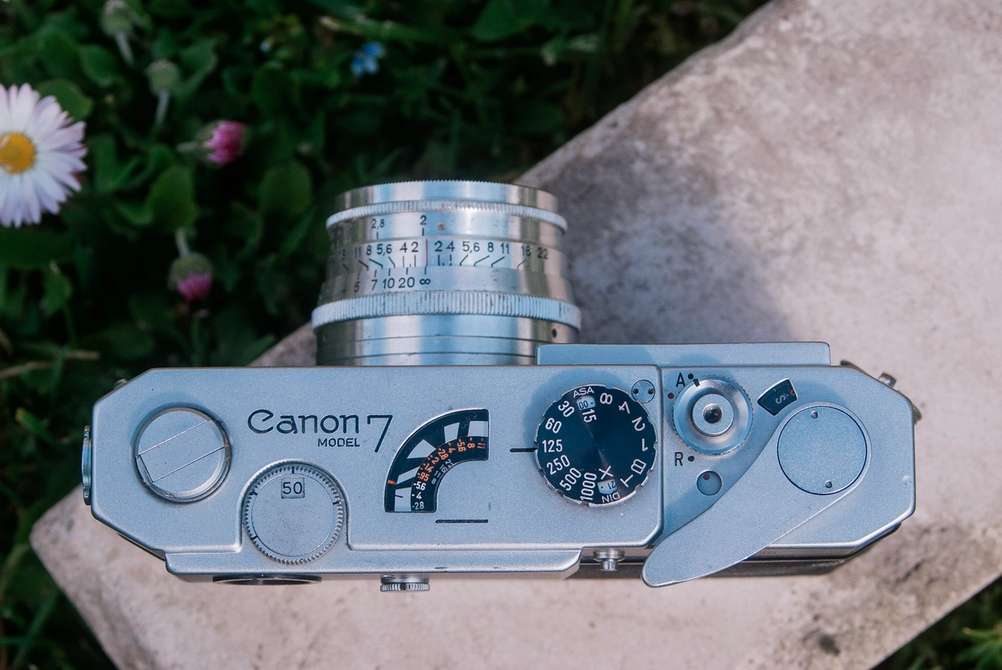
Canon Model 7 from the top with the Jupiter-8 lens. Jupiter was the first lens I put on Model 7.
Since I've got other LTM lenses it has been sitting on a shelf. Waiting. To be released from shelf life and be put on 7 again. Not to take photos with. But to actually be the subject of a photo.
Canon Model 7 is special to me. It was the first "proper" rangefinder camera I bought. It's the main reason why I love rangefinders now. And it also caused all the GAS I went through. So in some aspects the 7 has cost me a lot of money.
I've had two Model 7's - both from Japan. At the time they were cheaper. I have since sold one as I don't need to have two. I kept the one with a pretty functional light meter and shutter without any wrinkles.
I have shot a lot of rolls through Model 7. And because it uses an LTM mount I continued using all LTM lenses on Leica M3 since it's very easy to adapt LTM lenses to M mount. It's the perfect introduction drug to rangefinder life.
Aesthetics
It's a solid looking camera but I wouldn't call it very beautiful. Canon P is most definitely the more attractive older sibling.
I like the "Canon MODEL 7" branding on the top plate. Looks very nice. I also like the look in general.
What I don't like is how the light meter impacts the looks of the camera. I don't like how selenium cells look in general. I would actually say that there is no super beautiful camera with a selenium light meter. The light meter also makes the camera chunkier than it would be without it. I also dislike how the rangefinder window is integrated into the light meter section. In some ways it's nice. In other ways I dislike it hard.

That glass like thing with the smaller window inside it on the left is the light meter sensor. There are uglier implementations of selenium light meter cells but I'm not a fan of how they look in general.
I also dislike that the film rewind lever sticks out from the top plate. Why didn't they reuse the same principle as on Canon P or Canon VI?
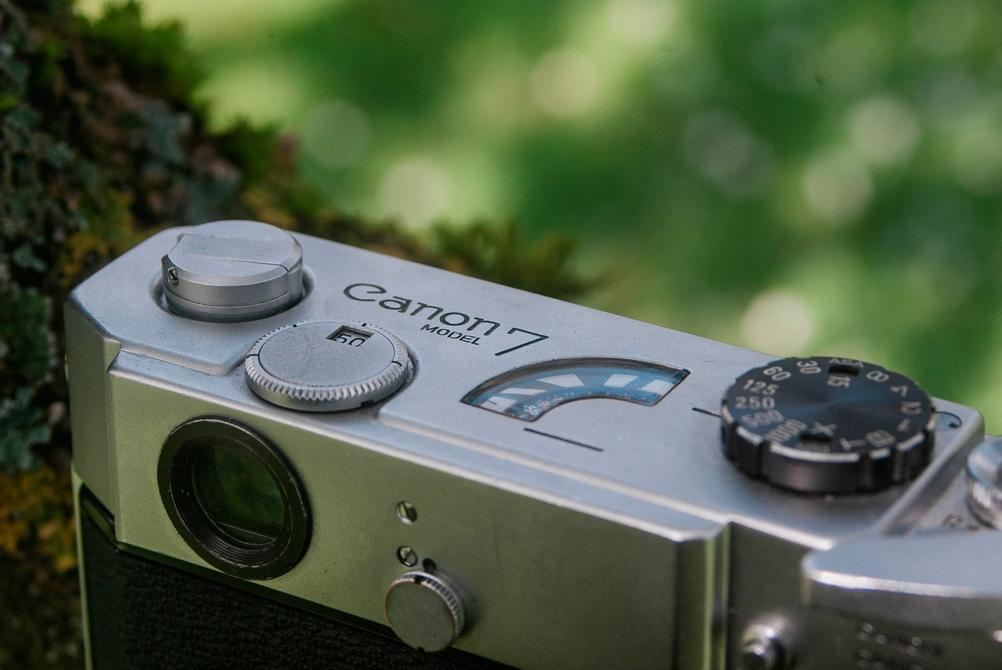
Film rewind control always extends from the top plate like this. I would much prefer if it was flush with the body.
It may seem like I dislike the looks and that's not true. I just think that it could look a lot better. The upgraded model 7s ( and 7sZ ) does get rid of the selenium light meter but it adds other things that don't improve the look of the camera.
Build Quality
Build quality is good. Everything fits together well. Nothing rattles. That being said - it doesn't have that solid piece feel that Leica M3 has. You can tell that Model 7 is a combination of pieces put together. Put together very well. But they are still separate. Leica M3 feels like one unit. The back door is especially hollow feeling on Model 7.
Shutter speed dial turns well with satisfying clicks. The ISO selector which is the same wheel as the shutter speed dial is also equally satisfying. Button that you need to press to move the ISO dial is a bit loose and not as satisfying.
Film advance lever has a nice resistance and a separate "ready to be used" step. It's pleasant to use. Not as pleasant as M3 though.
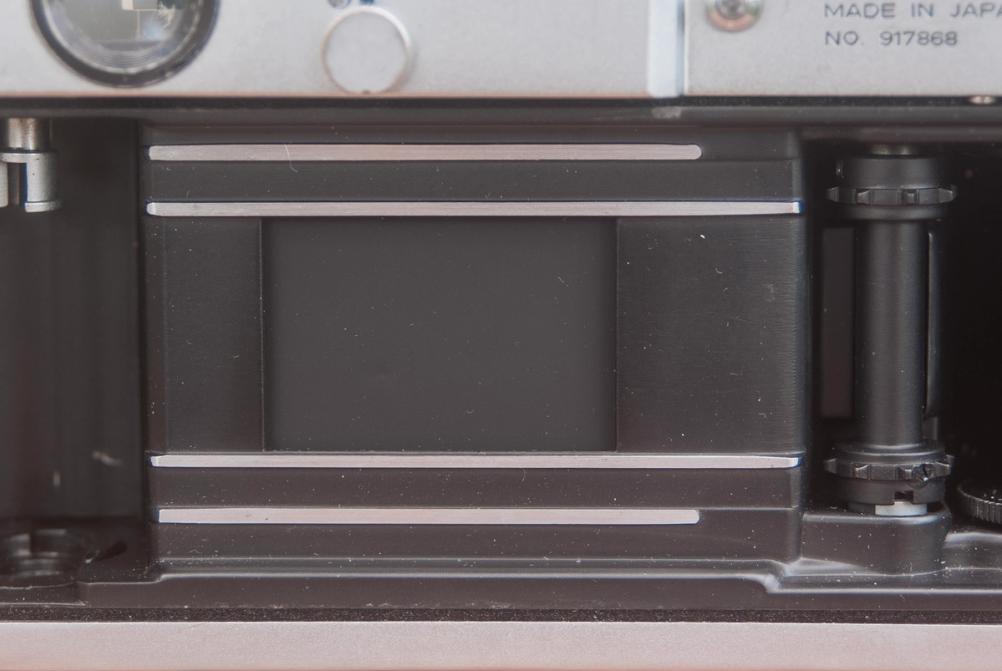
Most Canon LTM cameras with metal shutter curtains have a similar problem. Shutter curtains wrinkle. It doesn't cause any problems but can look weird.
My copy has a very smooth curtain which is quite a rarity.
All in all it's built well and is satisfying to use. It doesn't feel like it will fall apart or break easily. It's not as refined as a Leica but then it doesn't cost like one.
Viewfinder
Viewfinder is great. If you're not sure whether you'll like rangefinder cameras - try this camera. It's inexpensive enough to do so. It's not the best viewfinder in the world but it will give a good sign on whether you're rangefinder compatible.
Viewfinder is a good size. Magnification is about 0.7x. It will be better for wider and normal lenses. That being said, 35mm framelines are quite close to the edge. If you're wearing glasses it might not be possible to see the 35mm framelines in full.
Rangefinder patch is a rectangle with soft edges. An improvement over circular patches like on Canon P. That being said, the patch on Canon P might actually have a larger area than Model 7's one.
I don't know why soft edges are a thing in rangefinder patches. I much prefer hard edges. It's good that the contrast and size is good enough to make the focussing easy anyway.
Rangefinder vertical alignment was off with one of the Model 7 cameras I had. Luckily it's an easy fix that you can do at home as long as you have small screwdrivers. Horizontal alignment is not difficult as well but I have not needed to adjust that.
Best feature about the viewfinder are the framelines. You can switch between them and most are visible one at a time. That is fantastic! There's framelines for 35mm, 50mm, 85mm, 100mm and 135mm. Only 85mm and 100mm frame lines are shown together - others are separate. They are also parallax corrected so will accurately show you what's in frame regardless of focus distance. The way the frame lines appear is also nice. Borders are a nice width and with square edges. Better than M3's fat and round-ish 50mm framelines. They also show the size of the frameline within the viewfinder which can be helpful.
Almost top scores for the viewfinder in Model 7. Leica M3 has a better experience still but Model 7 does have some things better than M3.
Ease Of Use & Functionality
Of course it's easy to use. It's an old, mechanical film camera.
Shutter speed dial is at the very top and nothing surrounds it so it's easy to use with one finger. Shutter speeds range from 1 second to 1/1000th of a second. It also has a B and T mode. I especially like the T mode as it allows for easier long exposures if you don't have a shutter release cable.
Shutter button is in a good position. It feels natural to advance the film without any crazy hand positions. Ring around shutter button is used to switch between normal shooting mode and film rewind mode. There's also a setting to lock the shutter button. It will come in handy if you have cocked the shutter and need to put the camera away.
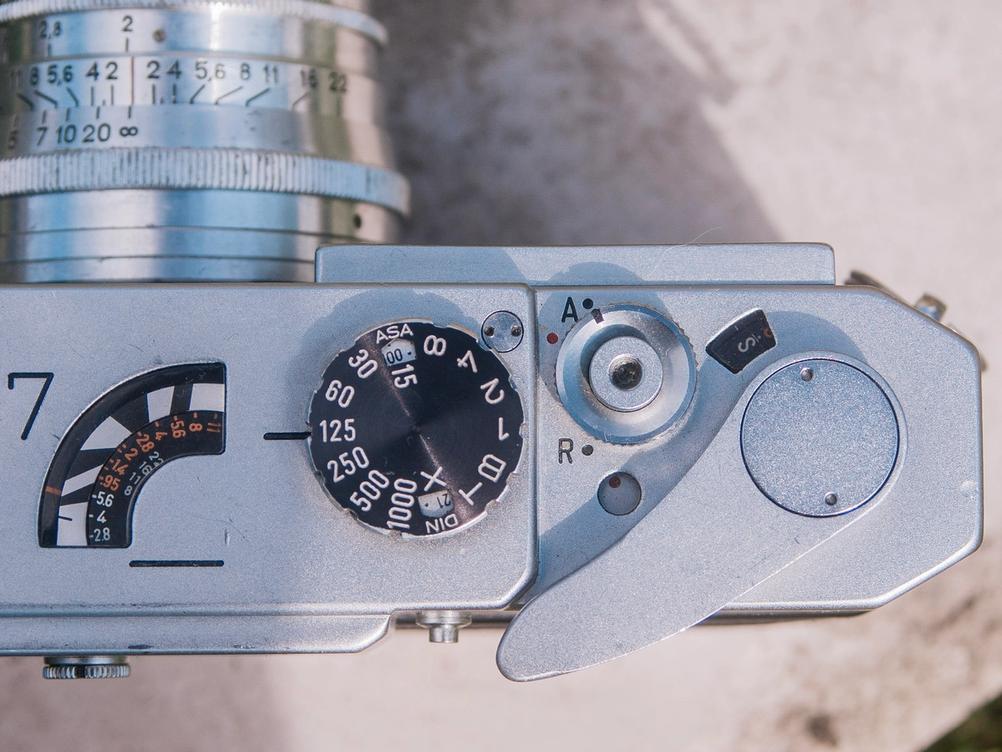
Camera controls from the right side of the top plate. From the right we have: film advance lever; exposure counter; shutter button; shutter mode toggle ( A for film advance, R for film rewind and red dot for lock ); film loading indicator - it will rotate when advancing film if film is loaded correctly; shutter speed dial with ISO setting wheel; light meter reading ).
Viewfinder position and surrounding area won't cause any problems whether you're a left or a right eye shooter.
Because it has the LTM lens mount you screw the lenses on and off as you need. But wait...although it's an LTM camera - it has a bayonet mount around the screw mount! What is it for? It's for the crazy 50mm f0.95 lens that was released for this camera. Canon had worries that the heavy weight of the f0.95 lens might cause issues on the LTM screw mount. It's a custom bayonet that's only available on Canon Model 7 ( and their updated versions - 7s and 7sZ ). These days you can find the lens converted to M mount as well. I have never used one as it's expensive.
To load the film one will need to open the back door. To do that you need to turn the lock on the bottom plate. That will allow another pin to be pulled to finally open the back door. Camera doesn't have any fast load technology but it's not difficult to load.
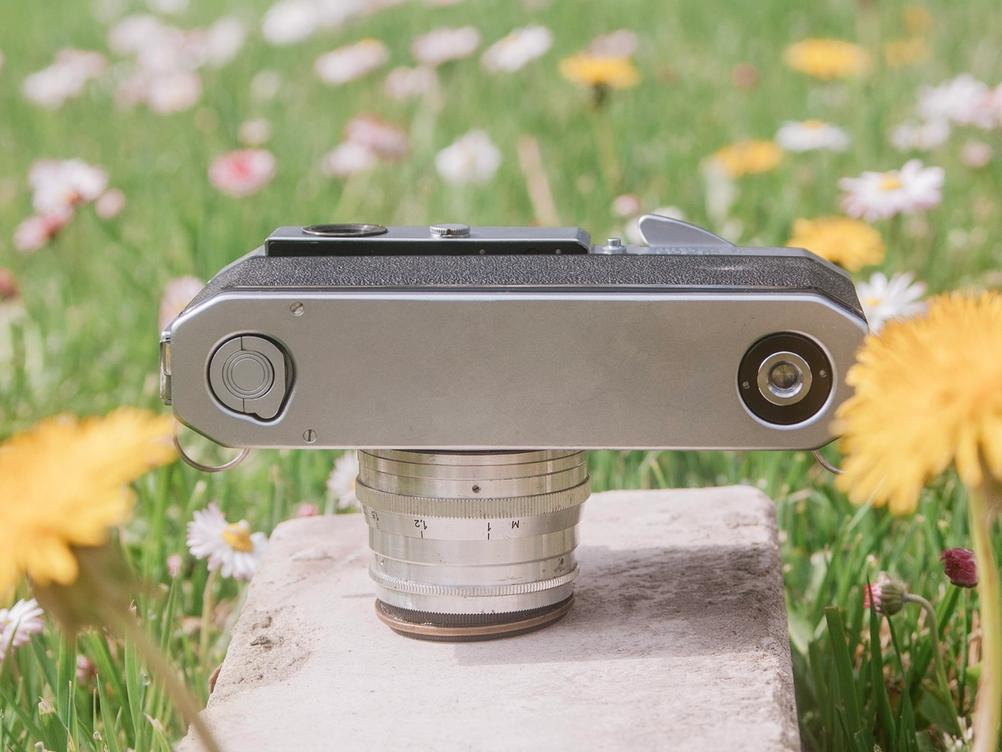
Bottom plate with the tripod mount on the right and back door opening lock on the left.
There are some areas for improvement as well.
It's not that easy to actually hold. Something like the Canon P which is smaller and lighter feels more natural in the hand. The light meter protrusion also makes it difficult to find a resting place for all fingers. At least one finger wants to go on top of the light sensor. That might impact meter reading so you better be aware of that.
Speaking of light meters. It's uncoupled meaning that it won't control the shutter speed for you ( like aperture priority mode ). You can see the reading from the top of the camera - next to the shutter speed dial. It will show you the aperture you should be in depending on the currently selected shutter speed. It won't warn you with bright lights or sounds if you're over or under-exposed. That is the life of an uncoupled light meter. It will support ISO from 6 to 400. There's no exposure compensation setting - just your brain. You can also switch it from low and high light mode. Indoors will typically need the low light mode and outdoors - the high mode. Finally the supported apertures are from f0.95 to f22.

Light meter reading can be seen from the top plate. Current reading tells us that at 1/125th shutter speed and 100 ISO film ( the window on my camera is slightly misaligned so it's hard to read the ISO ) we should set our aperture at f8.
White numbers should be used when light meter is set to low sensitivity ( when there's a lot of light ) and orange numbers when it's set to high sensitivity ( when there isn't a lot of light ).

This small circular toggle allows to switch between low / high sensitivity light meter reading. Currently it's set to low sensitivity as there's plenty of light around. Rotate it 180 degrees to change the setting.
It's difficult to tell from the picture ( and in real life ) but low sensitivity has a black indentation and high sensitivity has an orange one. Colors have largely faded over the years.
Frameline selector dial is almost flat against the top plate so it can be difficult to turn. You will need two fingers to turn it and even that can be difficult as there's not much to grip against. You only have to use it as you change focal length so it's not a constant issue.
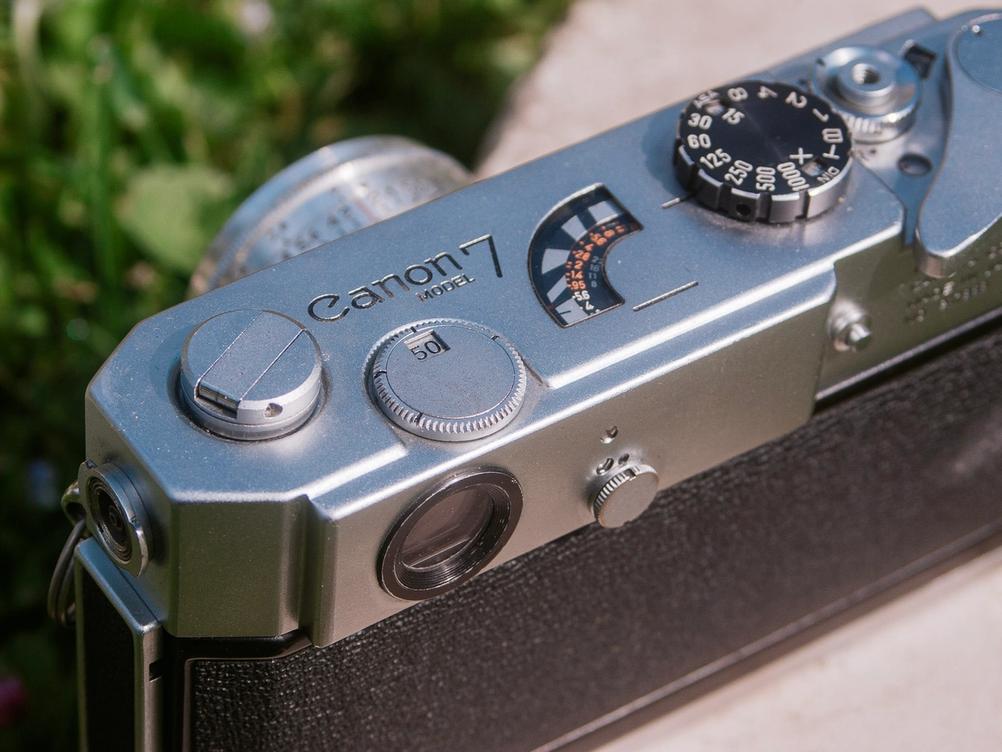
Frameline selector is quite flush with the body which makes it difficult to rotate it. If only they made the rewind lever more flush with the body...
The biggest issue with the camera is the lack of a cold / hot shoe. I like to use Voigtländer 15mm f4.5 lens and it requires an external viewfinder which mounts on the cold shoe. It can't be done on Model 7 which is a shame. It's not possible to attach accessories ( like external viewfinders or light meters ) to the cold shoe. Canon did release a special bracket with a cold shoe that you could attach to Model 7. It's rare and looks awful so you'll be better off getting a different camera for your accessories.
Even though I focussed on issues quite a lot - it's a fully featured camera that's easy to use. Unless you absolutely need the cold shoe - you likely won't experience any discomfort. Light meter is usable as it is but you will likely ignore it as most of them won't work today.
Results
As is common - analog cameras are not responsible for how the image looks. It's the lens, film and what you do with the film that matters. Camera is there to join all the parts together.
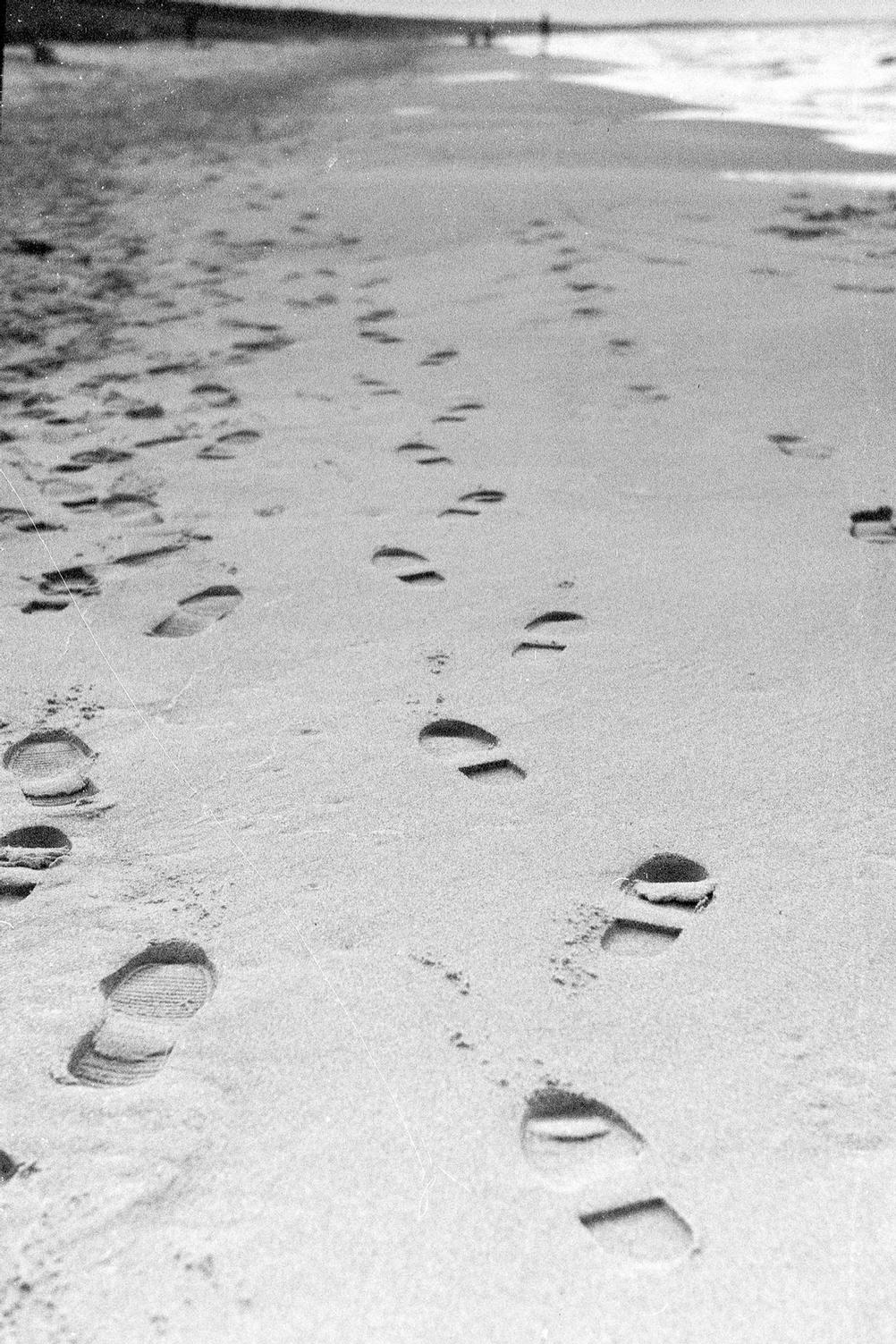
- Camera
- Canon Model 7
- Lens
- KMZ Jupiter-8 50mm f2
- Film
- Foma Fomapan 200 EI200
- Scanner
- Reflecta ProScan 10T
One of my first pictures taken with Canon Model 7. Ignore scratches and dust.
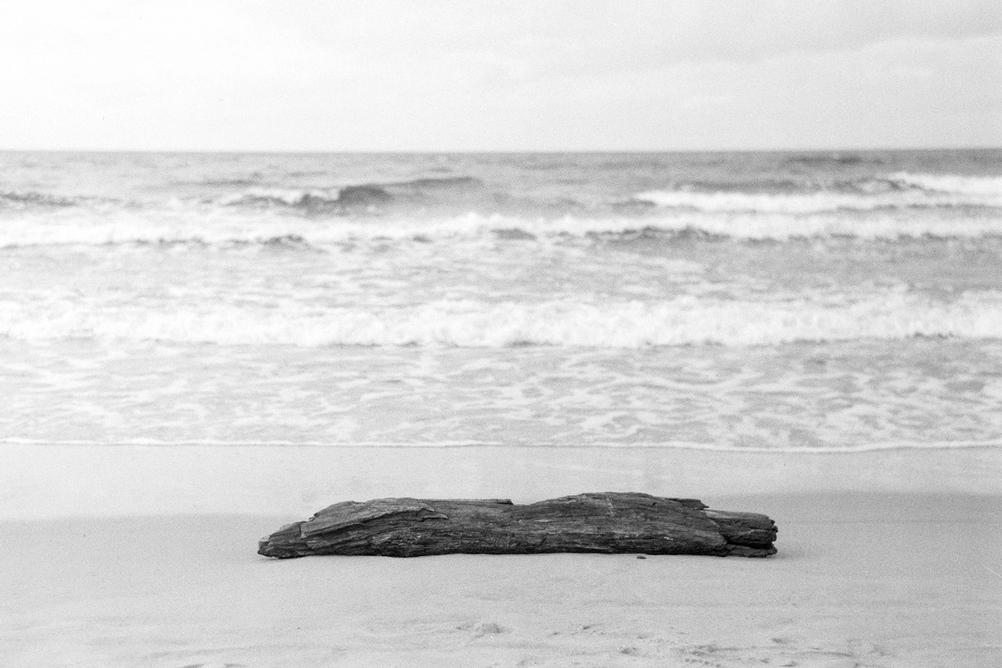
- Camera
- Canon Model 7
- Lens
- KMZ Jupiter-8 50mm f2
- Film
- Foma Fomapan 200 EI200
- Scanner
- Reflecta ProScan 10T
Jupiter-8 has a nice bokeh. At least on film. I remember not liking it on digital. Maybe I should shoot it some more. Or get the Zeiss version that Jupiter-8 is cloned from.
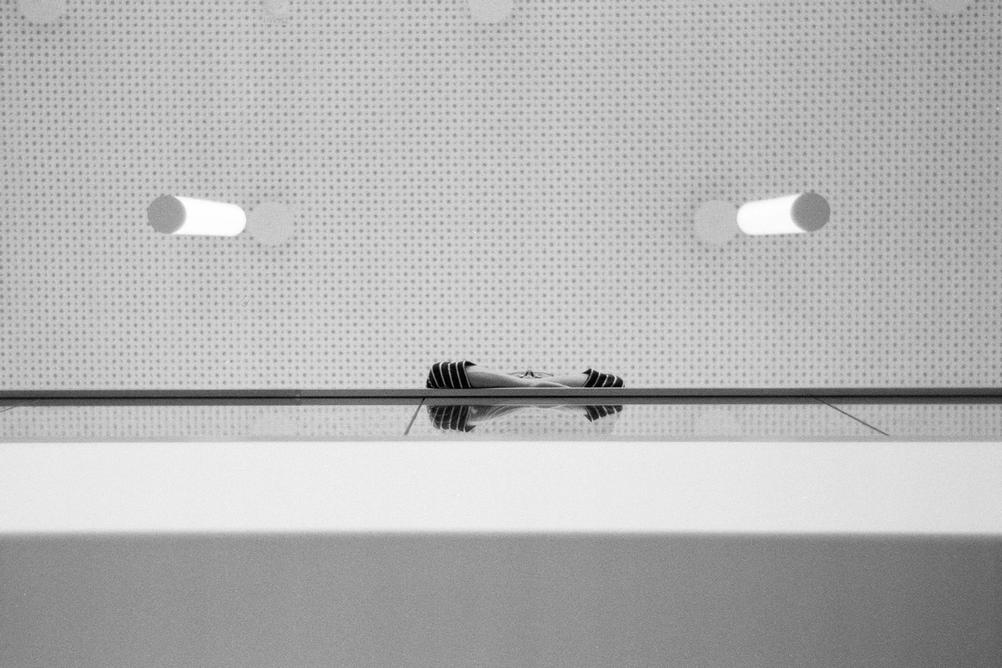
- Camera
- Canon Model 7
- Lens
- KMZ Jupiter-8 50mm f2
- Film
- Foma Fomapan 200 EI200
- Scanner
- Reflecta ProScan 10T
Taken in a large shop where you can't take photos. People take phone photos everywhere so I'm sure analog photos can be taken as well!

- Camera
- Canon Model 7
- Lens
- Leitz Elmar 90mm f4
- Film
- Fujifilm Reala EI100
- Development
- Compard Digibase Ready To Use Kit
- Scanner
- Reflecta ProScan 10T
Because Model 7 is a LTM camera you can mount various lenses on it. Including Leica lenses.
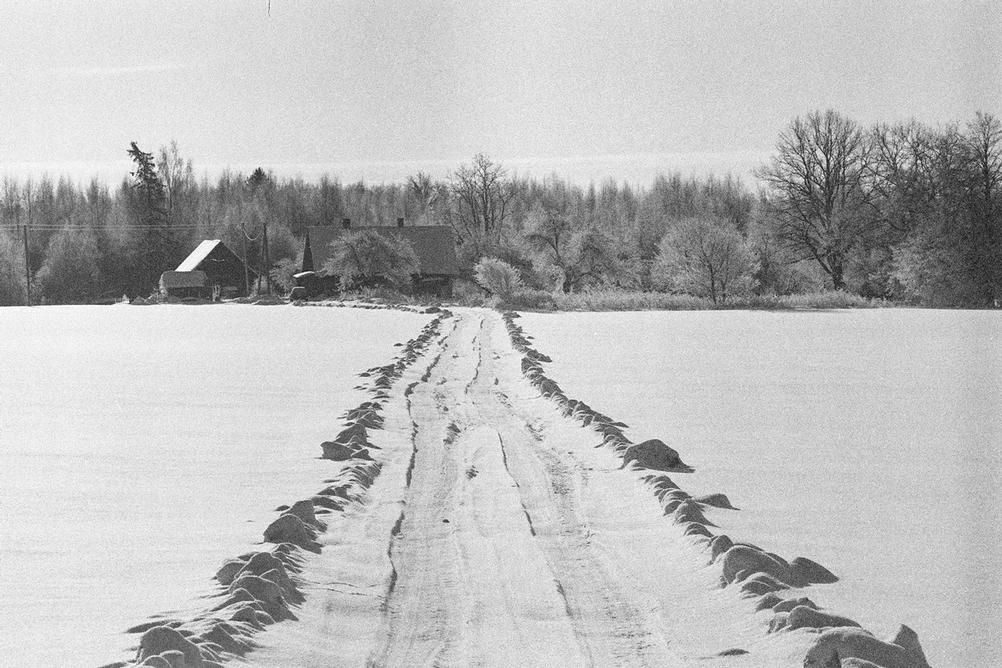
- Camera
- Canon Model 7
- Lens
- Canon LTM 135mm f3.5
- Film
- Kodak T-MAX 400 EI800
- Development
- Kodak HC-110; Dilution B; 7:00min
- Scanner
- Reflecta ProScan 10T
Even though Model 7 is not ideal for telephoto lenses - I like using the Canon LTM 135mm f3.5 lens on it for whatever reason. This combo has created many images that I like.
Review for this lens will be the next entry for the Canon LTM series.
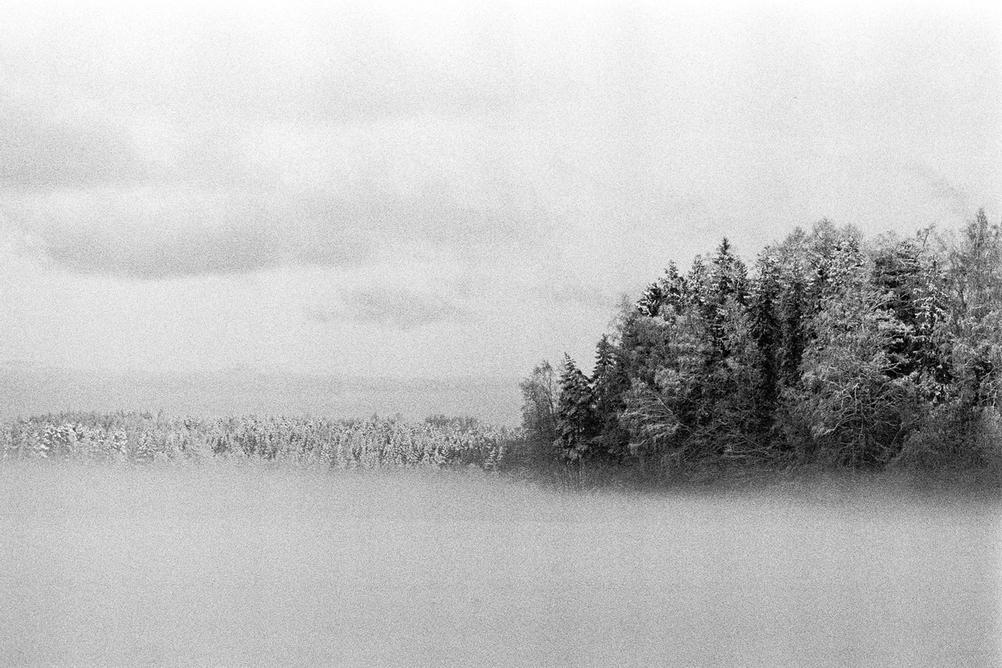
- Camera
- Canon Model 7
- Lens
- Canon LTM 135mm f3.5
- Film
- Ilford HP5+ EI200
- Development
- Compard R09 / Rodinal; Dilution 1:100; 1 hour semi stand
- Scanner
- Reflecta ProScan 10T
The 135mm lens combo seems to work especially well during winter time.

- Camera
- Canon Model 7
- Lens
- Canon LTM 135mm f3.5
- Film
- Ilford HP5+ EI200
- Development
- Compard R09 / Rodinal; Dilution 1:100; 1 hour semi stand
- Scanner
- Reflecta ProScan 10T
As you can see - I prefer Canon Model 7 with black and white film for whatever reason.
Verdict
Canon Model 7 is a great camera. It got me hooked on rangefinders and it may do the same to you. Prices are still reasonable and even quite small if you consider what you get. If you get it together with an equally well priced Canon 50mm f1.8 you'll get a great first rangefinder package. That's not to say that it's only good as a first rangefinder. I still use my Model 7 regularly.
If money was no object I would like to replace my Model 7 with Model 7sZ - the latest model and the last Canon LTM rangefinder that was released. For now they are too expensive to do that on a whim.
If you're thinking about getting a first rangefinder or an affordable LTM rangefinder - think no more. Canon Model 7 is a great camera. Get it. Unless you're allergic to rangefinders - you won't regret it.
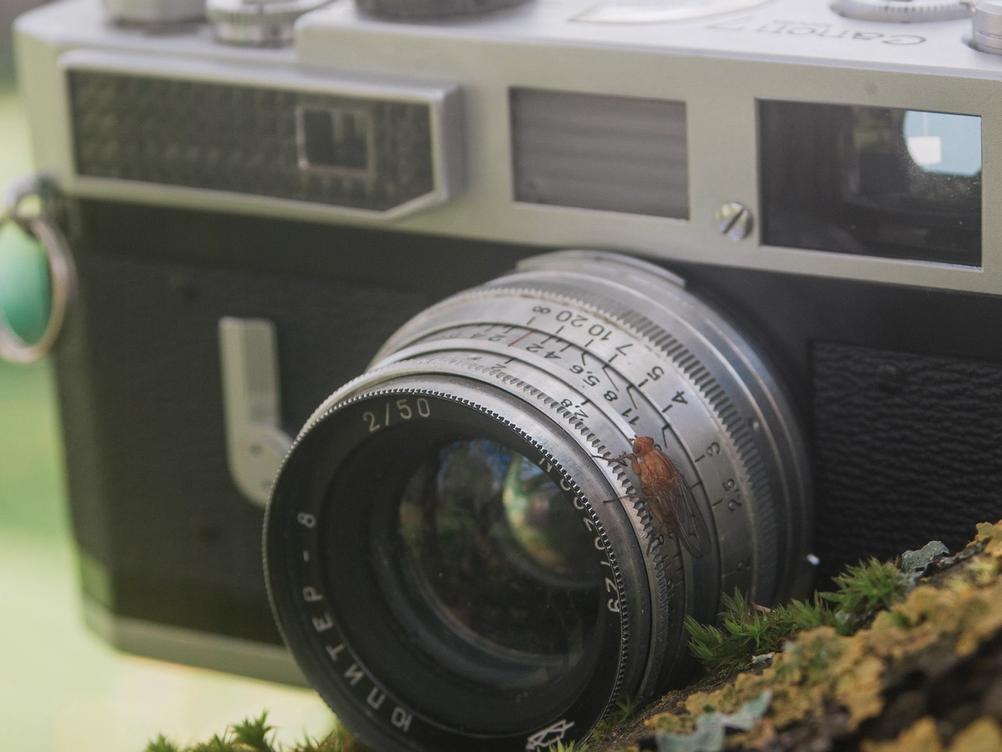
During the photo shoot an insect decided to take rest on the Jupiter-8. Let's make this insect internet famous!
